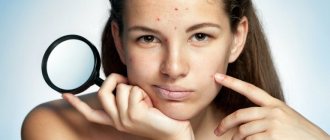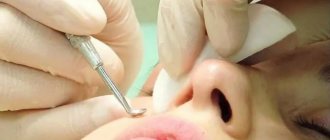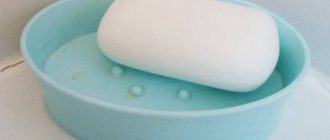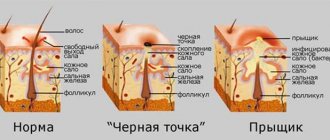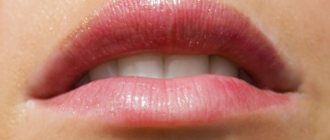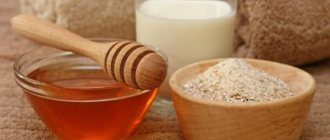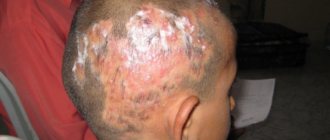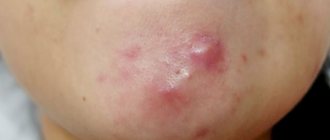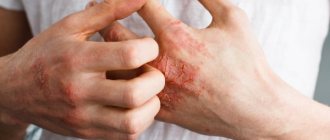The human body gets rid of dead skin cells through exfoliation. This is usually a gradual and unnoticeable process - a completely natural phenomenon that is not at all a sign of any problems.
Every 28 days, the outer layer of skin is completely replaced. This replacement can also be emergency - if it is provoked by the influence of external factors, such as exposure to the sun, friction and chemicals.
However, no one likes the feel and look of flaky skin. Dry, flaky, and red skin isn't fun by any means, but it's especially annoying when it happens on your face.
Whether it's caused by dryness, sunburn or irritation, no one wants to look like a shedding lizard. Probably every woman knows that it is almost impossible to apply makeup on flaky skin. But the skin on your face is more sensitive than other parts of your body, and facial peeling can sometimes even be painful.
Why does the skin peel?
First you need to understand why your face peels off? The factors behind this are internal and external reasons. They adversely affect the skin of the face and cause it to peel.
The main internal factors are:
- various chronic diseases;
- poor nutrition;
- initially dry skin;
- stress factors;
- impaired metabolism after many illnesses;
- hormonal imbalance;
- hypovitaminosis;
- long-term use of certain medications.
In these cases, before starting treatment for the peeling itself, you should be examined by a specialist and get rid of the main reason why the skin is peeling.
External factors that cause the face to peel are as follows:
- harmful influence of the external environment (extreme cold, drafts, wind, exposure to natural ultraviolet radiation and in solariums);
- long stay in a room where the air is dried out by heaters;
- various skin lesions;
- bad habits;
- use of soap for washing;
- allergies to food and drugs;
- improper use of cosmetics and unqualified actions of a cosmetologist.
If it is not always possible to avoid the influence of such factors, it is still quite possible to reduce their impact on the skin of the face.
Hormonal disorders
Cracks in the skin on the fingers and palms often appear in women during pregnancy, which is associated with changes occurring in their body. In addition, wounds are a signal that the expectant mother does not have enough vitamins.
A pregnant woman should first consult a gynecologist about cracks in the skin. If he deems it necessary, he will refer the patient for a consultation with a dermatologist.
Another category of people in whom cracks in the skin can be observed are the elderly. Due to age-related changes, they produce less collagen and fat, and their skin becomes very thin and dry. Together, these factors often cause cracks in the hands.
Adolescents during puberty and hormonal changes in the body are also at risk. According to medical statistics, they most often experience skin cracks on their fingers near the nails. Inept hand care and unprofessional manicure can contribute to this.
Preventing skin peeling
Despite the fact that internal causes cannot always be avoided, there are general tips that can help minimize their impact:
- healthy lifestyle, desire for proper nutrition;
- avoiding unnecessary stress;
- adequate sleep and rest;
- taking vitamins in the spring (the most common time of hypovitaminosis);
- timely visit to the doctor and treatment of existing diseases;
- taking medications under the supervision of a doctor.
If you follow these tips, the risk of encountering the unpleasant phenomenon of facial peeling will be significantly reduced.
The possibility of influence of external causes largely depends on the person. In this case, there are also simple preventive measures:
- in cold and windy weather, protect your face with a scarf and wide collar;
- Apply protective cream before going outside;
- remove makeup before bed with special foams;
- do not use lotions containing alcohol, which dry out the skin;
- use only products specifically designed for this purpose;
- humidify the air in the room;
- to refuse from bad habits;
- visit only trusted beauty salons.
All this is the guarantee that the skin will be healthy and will not peel off.
Sores near the nails
Skin cracks on the fingers are most often observed in the cuticle area. This is a thin strip of skin framing the nail from the side of the hole. Wounds in this area can appear for any of the reasons listed above. In addition, some women experience cuticle cracks due to manicure. If it is performed by a professional without experience, it can injure the thin and delicate skin around the nail. This applies to both classic manicure and hardware manicure. Nowadays, nail extensions are in fashion, as well as covering them with gel polish, for which a UV lamp is used.
All this was invented to create real masterpieces on your nails that should last a long time. However, the developers did not take into account the negative impact of the lamp. It can become one of the causes of cracked skin on the fingers. Experienced masters, performing manicures with a lamp, apply protective agents to the clients’ cuticles. If this is not done, the skin becomes very thin and cracks form on it. In addition, cuticles often become inflamed due to infection, which causes significant pain in women.
Tanning as a cause of peeling and preventive measures
In the summer season, almost every woman wants to get a beautiful tan. If a period has come when there is no longer solar activity, people visit solariums en masse. But exposure to ultraviolet radiation is one of the reasons why skin peels off.
Exposure to the sun should be limited in time. Sunbathing should be done gradually, especially when the skin is still light. You can stay in the sun for no more than 15-30 minutes. It depends on the degree of tanning and individual skin conditions. You can sunbathe on the beach from the morning until 10 o'clock or in the afternoon after 4 o'clock.
It is important to always apply special sunscreens, milks and sprays. We should also not forget that a single application is not enough. These products are easily washed off with water and require reapplication after swimming. After tanning, it is useful to treat the skin with special cosmetics.
Water enhances the effects of ultraviolet radiation, so swimming in a pond can cause sunburn faster.
You can stay in the solarium for no more than 10 minutes per session. If these are the first visits, then tanning is limited to an even shorter period of time. You should visit proven solariums where the staff changes the lamps on time.
Following these rules will allow you to maintain your beauty without getting an unpleasant “surprise” after tanning.
Diagnostics
To establish the causes of skin cracks on the arms and legs, a number of tests are required:
- Scraping Biomaterial from the skin surrounding the crack is taken. This analysis reveals the presence or absence of pathogenic fungi that are causing the problem.
- Allergen tests.
- General blood analysis. Hemoglobin and red blood cell levels are determined to exclude or confirm iron deficiency.
- Analysis for the presence of helminths.
- Biochemistry of blood.
- Be sure to conduct an examination of internal organs, in particular, determine the levels of glucose and glycosylated hemoglobin. They are one of the main ones for diagnosing diabetes mellitus, which often causes cracks in the skin.
Treatment with drugs from the pharmacy
If it was not possible to avoid the problem in time, the skin is already peeling off and flaking, pharmaceuticals and medical procedures will come to the rescue. They will help speed up healing and the skin will return to its healthy appearance.
If the cause of peeling is various internal diseases, you should consult a doctor who will select the necessary therapy. The list and doses of drugs should be selected by a doctor. He or she will prescribe anti-inflammatory drugs, antibiotics, or antifungals for a bacterial or fungal infection.
Ointments and creams that contain hydrocortisone also help eliminate flaking. But the use of such drugs is strictly limited in time and frequency of application. Therefore, you should first consult a dermatologist first.
One of the best drugs that have a healing effect is “Panthenol” and other drugs made on the basis of dexpanthenol. This drug is especially recommended for tan lovers who experience peeling due to sunburn.
After using Bepanten baby cream, flaking is reduced and the healing of minor skin lesions is accelerated.
If the peeling is severe and you cannot cope with it on your own, you should do special procedures in a beauty salon. When the facial skin peels off, the cosmetologist may suggest the following activities:
- mesotherapy, in which hyaluronic acid is injected into the skin using micro-injections;
- peeling using scrubs and exfoliating masks;
- Biorevitalization will help with patchy peeling.
During the biorevitalization process, special restorative preparations are injected directly into problem areas of the face. After using cosmetic procedures, the skin becomes smooth.
Cracked heels
It is believed that this problem is typical only for older people, especially those who often walk without shoes on various hard surfaces (ground, dusty road, etc.). However, this is only partly true. The causes of skin cracks on the heels can also be both external and internal, which include all the diseases listed above.
In addition, the following factors can cause wounds on the legs:
- Wearing shoes of poor quality (made from artificial materials), which causes an allergic reaction.
- Increased sweating.
- Wearing uncomfortable shoes that pinch or rub.
- Unstable heels.
- Lack of proper foot care (many people limit themselves to only washing their lower extremities, not thinking that there are special creams, scrubs, masks for feet).
Separately, it is necessary to say about mycoses. The feet are most often affected by all kinds of pathogenic fungi. Without treatment, the disease in 100% of cases causes cracks, inflammation and peeling of the skin, accompanied by severe itching.
If the fungus appears on the hands, most often it is localized on the palms and between the fingers.
If parasitic microorganisms have infected the feet, cracks may also appear between the toes. In addition, they are observed on the soles and heels.
Traditional methods of treatment
Do not forget that folk remedies that have been tested over the years are successfully used at home. To do this, take natural ingredients: honey, milk, vegetables and grain flakes, vegetable oils.
Bring honey to a liquid state and dilute with water in equal proportions. Use the resulting mixture to wash your face instead of water. This recipe works well if you have peeling spots.
Add a little honey and one spoon of olive oil to warm milk oatmeal. You can replace the porridge with crushed oatmeal, and use an egg yolk instead of butter. This mask will effectively remove dead skin cells from the surface of the face.
It is useful to make various scrubs, for example, made from coffee grounds, bread crumbs or ground nut kernels.
An aloe mask will help speed up skin healing and remove inflammation. To do this, grind the plant and the resulting pulp is first kept in the refrigerator for some time, then mixed with egg white. Apply to the face, after lubricating it with cream.
One of the proven methods to help eliminate flaking after sunbathing is the use of masks based on fermented milk products. These recipes use full-fat kefir, cream, yogurt or sour cream. For example, you can make a mask from cucumber pulp mixed with one of these products.
Home remedies are used in complex therapy; it is not advisable to make them the only method of treatment. That’s why it’s a good idea to first consult a dermatologist and then resort to them.
Foot therapy methods
To treat wounds on the arms and legs, two main treatment methods are used:
- Using external means.
- Drugs taken orally.
As a rule, these methods work in combination.
Various remedies are used to heal cracks in the legs and arms.
Externally for the treatment of cracked skin of the heels use:
- "Radevit."
- "Calendula".
- Zinc ointment.
- "Balsamed"
- "Bepanten."
- Regular Vaseline.
- "Zazhivin."
Before applying the ointment, it is advisable to steam your feet by making a bath with sea salt (1 tablespoon per 1000 ml of water) or herbal decoctions (chamomile, calendula, nettle). The duration of the procedure is up to 30 minutes, but you need to make sure that the water remains warm all the time. You can also add essential oils of lemon, lavender, sea buckthorn, and calendula to the bath. After the procedure, it is advisable to carefully remove dead skin from the heels with a pumice stone, wipe well, apply cream and put on socks.
There are special sock masks on sale that have an insert that has healing properties.
Hand therapy methods
You can also use baths to treat cracked hands. They relieve irritation, soothe pain, itching, heal wounds, and nourish the skin. Hand baths can be made with the same ingredients as for feet. Herbal decoctions are prepared in the amount of 1 tsp. dry mixture per 1000 ml of boiling water. They need to pour the grass and let it brew. Next, the infusion is filtered and used for its intended purpose.
The most popular hand creams are listed below.
For healing cracks:
- "Solcoseryl".
- “It makes me happy.”
- "Levomikol".
- "BoroPlus".
- "Pantestine".
To relieve itching:
- "Psilobalm."
- "Fenistil".
To relieve inflammation and protect against infection:
- "Triacort."
- "Beloderm".
- "Elokom".
- "Kutivate."
- "Dermovate."
Imported drugs:
- Lipikar.
- HIDRADERM Sesvalia.
- Remederm silver.
- Cutibaza.
- Locobase Repair.
When choosing a softening hand cream, make sure that it contains lanolin, propylene glycol, glycerol stearate, and squalene.
Moisturizing creams should contain glycerin, lactic and hyaluronic acids, sorbitol, and propylene glycol.
If the tube with the cream says that it is healing, it must contain at least one or two elements from the list:
- Vitamins A or E (it’s good if you have both).
- Propolis oil, sea buckthorn, chamomile, jojoba, grape seed, avocado.
- Lanolin.
- Essential oils of tea tree, eucalyptus, lemon, chamomile, calendula.
A good effect in healing cracks in the hands is observed if a person adheres to the following algorithm:
- Makes a bath for 20 minutes.
- He wipes his hands dry.
- Apply cream.
- Puts on light cotton gloves.
Of course, you need to perform such procedures before going to bed. To moisturize the skin, you can use regular Vaseline, which should be applied in a thick layer.
Note that if the patient has mycoses, the dermatologist prescribes medicinal ointments, which may include:
- "Nizoral."
- "Clotrimazole".
- "Ketoconazole".
- "Lamisil."
- "Mikospor".
For pregnant women, even drugs for external use should only be prescribed by a doctor, since many drugs have a negative effect on the development of the fetus. Most often, pregnant women are prescribed Prednisolone and Hydrocortisone.
Oral medications are prescribed when diseases of internal organs, helminthiasis, and stress are detected. In addition, almost every patient is prescribed a course of vitamin therapy.
Salon treatments
For those who don’t want to wait, make and regularly use homemade masks, cosmetologists offer a choice of the following techniques:
- mesotherapy, based on the injection of special cocktails that quickly replenish the deficiency of moisture and vitamins in the skin tissue, thereby eliminating the dryness of the epidermis;
- biorevitalization (injection or hardware), which consists in the use of compositions based on hyaluronic acid, instantly moisturizing, smoothing, increasing the firmness and elasticity of the skin;
- a mechanical or chemical type of peeling, when the old keratinized and dead epithelial layer is completely removed, and a renewed, young epidermis is formed in their place. The new skin tissue will be moisturized and free from dryness due to the activation of the synthesis of its own hyaluronic acid and important connective tissue fibers (collagen and elastin).
The duration of treatment using such methods is determined by the cosmetologist for each patient individually in the absence of serious diseases, and also taking into account the degree of dryness of the epidermis.
What else should you do for dry skin:
- Drink enough water. The recommended dosage is 30 ml for each kg of weight. Coffee and strong tea should be limited, and soda, sweet juices and alcohol in any form should be excluded altogether.
- Eat properly. For beautiful, healthy skin you need protein from lean meat, fish and eggs, unsaturated fats from vegetable oils, nuts, low-fat dairy products, enough complex carbohydrates from vegetables and cereals for good digestion. And dryness is provoked by pickles, sweets, flour, fatty, fried foods.
- Protect your skin from the sun, wind and frost with hats and accessories.
- Take vitamin and mineral complexes. They must be prescribed by a doctor. The most popular complexes: Lady's Formula, Merz, Alphabet Cosmetic, Viardot, Vitrum Beauty, Doppelgerz, Complivit Radiance. As reviews say, sometimes the best option is simple and inexpensive fish oil.
- Regularly perform special gymnastics for the face. Exercises rejuvenate, improve blood circulation, supply tissues with moisture, and remove toxins. The sooner you start, the longer you will maintain your youth, and dry facial skin will not bother you.
Write comments, share the article on social networks, subscribe to updates.

